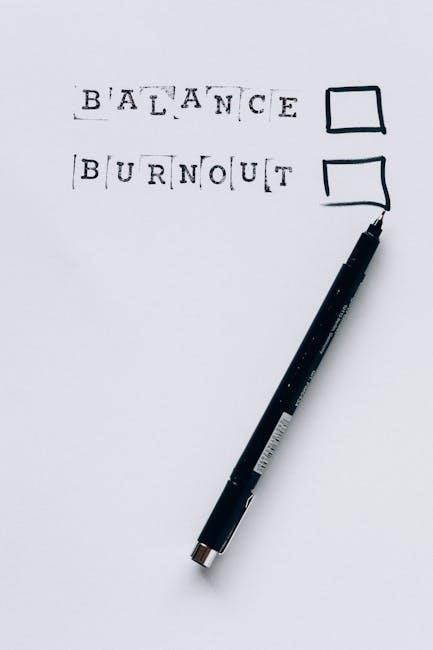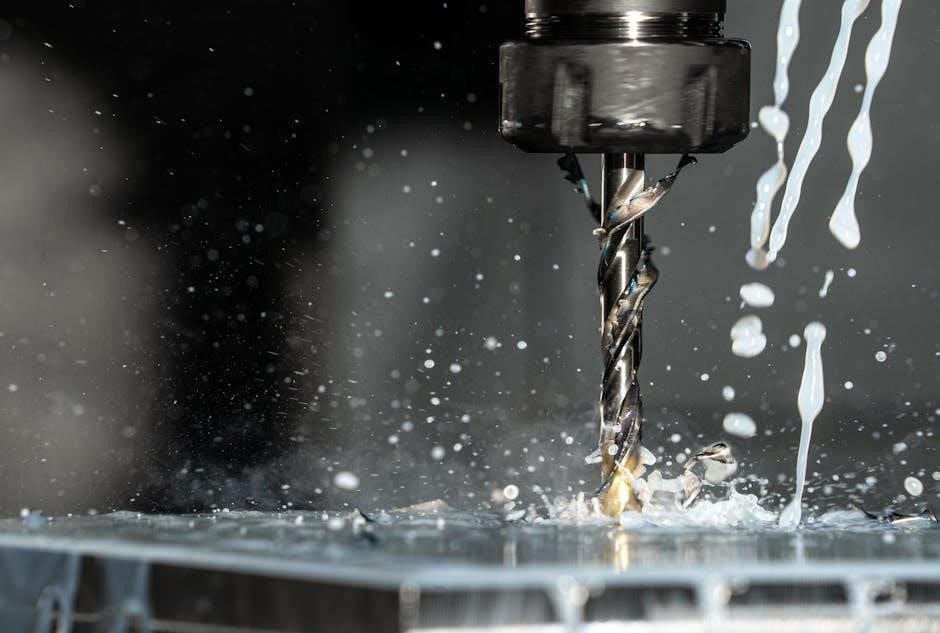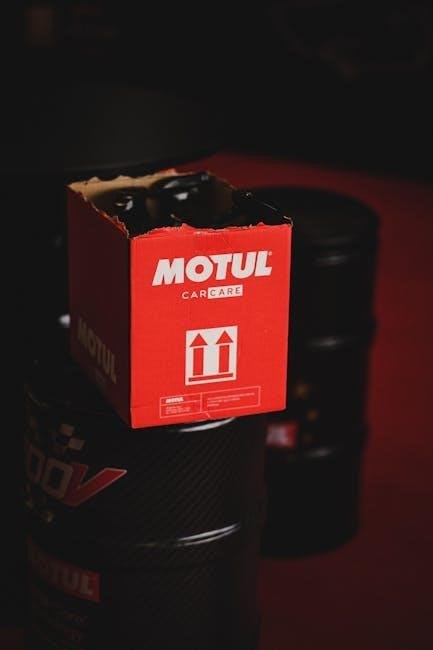Lubricant failure mechanisms are complex, involving thermal degradation, contamination, and wear processes. Understanding these is crucial for preventing premature wear and ensuring machinery longevity and efficiency.
1.1. Overview of Lubricant Failure Mechanisms
Lubricant failure mechanisms encompass various processes that impair a lubricant’s ability to reduce friction and protect machinery. Primary mechanisms include thermal degradation, contamination, and wear. These failures often result from inadequate lubricant properties, environmental factors, or operational stress. Understanding these mechanisms is vital for preventing premature wear, reducing downtime, and ensuring optimal equipment performance. Addressing these issues requires a comprehensive approach to lubricant selection, maintenance, and monitoring.
1.2. Importance of Understanding Failure Mechanisms
Understanding lubricant failure mechanisms is critical for preventing premature equipment wear and optimizing maintenance practices. Identifying root causes ensures timely interventions, reducing downtime and operational costs. This knowledge also aids in selecting the right lubricants and implementing effective monitoring strategies. By addressing failures proactively, industries can enhance equipment lifespan, improve efficiency, and minimize financial losses. Effective lubricant management directly impacts productivity and resource allocation, making it essential for modern industrial operations.
1.3. Common Types of Lubricant Failures

Thermal Degradation in Lubricants
Thermal degradation occurs when high temperatures break down lubricants, leading to oxidation and loss of viscosity. This reduces lubricant effectiveness and accelerates equipment wear.
2.1. Causes of Thermal Degradation
Thermal degradation in lubricants is primarily caused by exposure to high operating temperatures, leading to oxidation and breakdown of the lubricant’s molecular structure. Prolonged heat exposure can also degrade additives, reducing their effectiveness. Inadequate cooling systems and excessive friction from moving parts further exacerbate thermal stress. Moisture presence can accelerate degradation, while poor lubricant formulation may lack thermal stability, making it prone to failure under high-temperature conditions.
2.2. Effects of High Temperatures on Lubricants
High temperatures cause lubricants to degrade by breaking down their molecular structure, leading to a loss of viscosity and reduced film strength. This results in increased friction, wear, and metal-to-metal contact, accelerating component failure. Thermal stress can also deplete additives, reducing the lubricant’s protective properties. Prolonged exposure to heat may cause oxidation, forming harmful deposits and promoting corrosion, ultimately leading to premature system failure and downtime.
2.3. Preventing Thermal Degradation
To prevent thermal degradation, select lubricants with high thermal stability and use cooling systems to maintain optimal temperatures. Regular monitoring of lubricant condition through viscosity checks and oxidation analysis can detect degradation early. Changing lubricants when necessary and ensuring proper ventilation also help mitigate thermal stress. These proactive measures reduce wear and prolong equipment lifespan, minimizing downtime and maintenance costs effectively.

Contamination-Induced Lubricant Failure

Contamination is a primary cause of lubricant failure, introduced through particles, moisture, or chemicals. These contaminants degrade lubricant properties, causing wear, corrosion, and system failure, requiring immediate action.
3.1. Types of Contaminants (Particles, Moisture, etc.)
Contaminants in lubricants include solid particles, moisture, and dissolved gases. Solid particles cause abrasive wear, while moisture leads to chemical reactions and degradation. Dissolved gases like oxygen promote oxidation, reducing lubricant life. These contaminants enter through improper storage, handling, or system infiltration. Effective filtration and sealing are critical to prevent contamination, ensuring optimal lubricant performance and machinery longevity.
3.2. Impact of Contamination on Lubricant Performance
Contamination significantly degrades lubricant performance, accelerating wear and premature failure. Particles abrade surfaces, while moisture induces chemical degradation and oxidation. This reduces the lubricant’s film strength, leading to metal-to-metal contact. Increased wear particles further exacerbate the breakdown, creating a cascading failure effect. Contamination also compromises additive effectiveness, reducing the lubricant’s ability to protect equipment, ultimately causing downtime and increasing maintenance costs.
3.3. Strategies to Minimize Contamination
To minimize contamination, implement proper storage, handling, and filtration of lubricants. Use high-quality filters to remove particles and moisture. Ensure equipment is sealed to prevent ingress of contaminants. Regularly inspect and maintain storage containers. Train personnel on clean lubrication practices. Monitor lubricant condition through oil analysis to detect contaminants early. Use desiccant breathers and consider nitrogen blanketing for moisture-sensitive applications. These practices help preserve lubricant integrity and prevent premature failure.

Wear Mechanisms in Lubricant Failure
Wear mechanisms in lubricant failure are critical factors, encompassing abrasive, adhesive, and fatigue wear. These degrade machinery by causing surface damage and reducing lubricant effectiveness.
4.1. Abrasive Wear

Abrasive wear occurs when foreign particles in the lubricant scratch or erode moving surfaces, leading to increased wear and tear. These particles, often from contamination, disrupt the lubricant film, causing metal-to-metal contact. Over time, this results in surface degradation, reduced component lifespan, and potential machinery failure. Addressing abrasive wear requires proper filtration, contamination control, and regular lubricant monitoring to maintain equipment integrity and performance;
4.2. Adhesive Wear
Adhesive wear occurs when a lubricant fails to prevent metal-to-metal contact, causing surfaces to stick together and transfer material. This leads to increased friction, heat, and wear. Inadequate lubricant film strength or contamination can trigger this mechanism. Over time, it results in surface damage, reduced component life, and machinery downtime. Addressing adhesive wear requires selecting lubricants with strong film strength and ensuring proper contamination control to minimize wear and extend equipment lifespan.
4.3. Fatigue Wear
Fatigue wear occurs due to repeated stress on surfaces, leading to crack formation and material failure. Inadequate lubrication allows metal-to-metal contact, increasing stress and crack propagation. This results in surface degradation, component failure, and machinery downtime. Addressing fatigue wear requires proper lubricant selection and maintaining optimal operating conditions to reduce cyclic stress and prevent premature material exhaustion.

Viscosity Failure Modes
Viscosity failures occur when lubricants thin or thicken due to temperature or oxidation, reducing their protective film strength and leading to increased wear and machinery damage.
5.1. Viscosity Breakdown Causes
Viscosity breakdown occurs due to high temperatures, oxidation, and shear stress. These factors degrade the lubricant’s molecular structure, reducing its film strength. Contaminants and improper storage also contribute, causing the lubricant to lose its protective properties. Regular monitoring and proper lubricant selection are essential to mitigate these issues and maintain optimal viscosity levels for machinery performance.
5.2. Consequences of Viscosity Failures
Viscosity failures lead to inadequate lubrication, causing metal-to-metal contact, increased wear, and heat generation. This results in premature component damage, reduced efficiency, and potential equipment failure; Over time, these issues escalate, leading to costly repairs and downtime. Addressing viscosity-related failures is critical to maintaining operational integrity and extending equipment lifespan.
5.3. Maintaining Optimal Viscosity Levels
Maintaining optimal viscosity ensures proper lubrication, reducing wear and heat. Regular viscosity checks, using high-quality lubricants, and controlling temperatures are essential. Monitoring for contamination and degradation helps prevent viscosity breakdown. Proper storage and handling practices also maintain lubricant integrity. By adhering to these practices, equipment operates efficiently, minimizing downtime and extending component life.

Case Studies and Real-World Examples
Real-world examples highlight common lubricant failures, such as bearing failures from inadequate lubrication and gear wear due to contamination. These cases provide practical insights into failure prevention and mitigation strategies, emphasizing the importance of proper lubricant selection and maintenance practices to avoid downtime and equipment damage.
6.1. Common Lubricant Failure Scenarios
Common lubricant failure scenarios include thermal degradation, contamination, and viscosity breakdown. Moisture ingress and particle contamination often lead to premature wear and machinery downtime. Inadequate lubrication and high-temperature operations can also cause lubricant film collapse, resulting in metal-to-metal contact and accelerated wear. These scenarios highlight the importance of proper lubricant selection, maintenance, and monitoring to prevent failures and ensure optimal equipment performance.
6.2. Lessons Learned from Industrial Applications
Industrial applications reveal that lubricant failure often stems from contamination, thermal stress, and improper selection. Regular monitoring, effective filtration, and timely replacement can mitigate these issues. Proper lubricant storage and handling are equally critical. These insights emphasize proactive maintenance and tailored lubrication strategies to enhance equipment reliability and reduce downtime, as highlighted in various case studies and industrial reports on lubricant failure mechanisms.

Preventing Lubricant Failure Mechanisms
Preventing lubricant failure involves proper selection, contamination control, and regular monitoring. Using high-quality lubricants and maintaining optimal operating conditions are key strategies to ensure longevity and performance.
7.1. Proper Lubricant Selection
Proper lubricant selection is critical to preventing failures. It involves choosing the right viscosity, base oil, and additives for specific applications. Ensuring compatibility with operating temperatures and contamination risks is essential. High-quality lubricants with adequate film strength can minimize wear and adhesion issues. Regular monitoring and timely replacement further enhance equipment reliability and longevity, reducing downtime and maintenance costs significantly. Proper selection is the foundation of effective lubrication management.
7.2. Regular Maintenance Practices
Regular maintenance practices are vital to prevent lubricant failure. This includes routine checks for contamination, monitoring lubricant condition, and ensuring correct application methods. Cleaning storage containers and using proper handling techniques can minimize moisture and particle ingress. Timely replacement of filters and lubricants helps maintain optimal performance. Consistent maintenance schedules reduce wear mechanisms and prevent premature failure, ensuring equipment operates efficiently and reliably over time.
7.3. Monitoring Lubricant Condition
Monitoring lubricant condition is essential for detecting early signs of degradation or contamination. Regular oil analysis can identify particles, moisture, and viscosity changes, preventing premature failure. Techniques like particle counting and viscosity testing help assess lubricant health. By scheduling routine inspections and maintaining detailed records, potential issues can be addressed before they escalate, ensuring optimal performance and extending equipment lifespan.

8.1. Summary of Key Findings
Lubricant failure mechanisms are primarily driven by thermal degradation, contamination, and wear processes. These factors can lead to premature wear, reduced efficiency, and equipment downtime. Regular monitoring, proper lubricant selection, and maintenance practices are essential to mitigate these risks and ensure optimal performance. Understanding these mechanisms is critical for preventing failures and extending machinery lifespan in industrial applications.
8.2. Advancements in Lubricant Technology
Advancements in lubricant technology focus on developing high-performance formulations that resist thermal degradation and contamination. Innovations include synthetic lubricants, nanotechnology, and advanced additives to enhance viscosity stability and film strength. These improvements aim to minimize wear mechanisms and extend equipment lifespan. Modern lubricants are designed to operate under extreme conditions, reducing downtime and maintenance costs while improving overall efficiency and reliability in industrial applications.
8.3. Best Practices for Lubricant Management
Best practices for lubricant management include regular condition monitoring, proper storage, and contamination control. Implementing filtration systems and using clean storage containers prevents moisture and particle ingress. Selecting the right lubricant for the application and adhering to recommended viscosity levels is critical. Scheduled maintenance, timely replacements, and staff training on lubrication techniques further ensure optimal performance and minimize failure risks, enhancing overall equipment reliability and operational efficiency.
